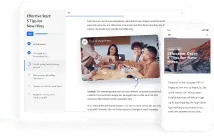Creating an Online Course with AI: 5 Dos and Don’ts

Would you like to create an online course using AI? The idea is definitely tempting: tools like ChatGPT promise efficient personalization and automation to help you build course content in record time. And that’s true! With artificial intelligence, you can speed up course creation by letting it generate content ideas, improve course structure, and even create multimedia course elements almost instantly.
However, you should be aware of the possible pitfalls of AI. It’s not always 100% accurate, and it sometimes creates generic course content with little value for your learners.
To help you leverage ChatGPT and other AI tools for an optimized online course creation process, we’ve created this comprehensive AI dos and don’ts guide. Read on and learn to use AI to your advantage and avoid its shortcomings.
Useful AI Features for Creating Online Courses
What makes AI a potentially powerful assistant for an online course creator? The technology is constantly evolving and now has a wide range of capabilities that come in handy in the process of building learning content. Here are some of the key features that AI can offer for course creation:
Also read → How to Create an Online Course
Natural language processing and generation
Natural language processing (NLP) is the ability of a computer program or algorithm to understand and analyze written or spoken language. Natural language generation (NLG) is, as you might have guessed, the ability to produce natural written or spoken language based on a data set available to the algorithm.
Think of an AI tool such as Apple’s Siri or Amazon’s Alexa: these voice assistants leverage both NLP and NLG to communicate with users and execute their requests. The same goes for ChatGPT – the bot understands and processes your written prompts to generate relevant replies.
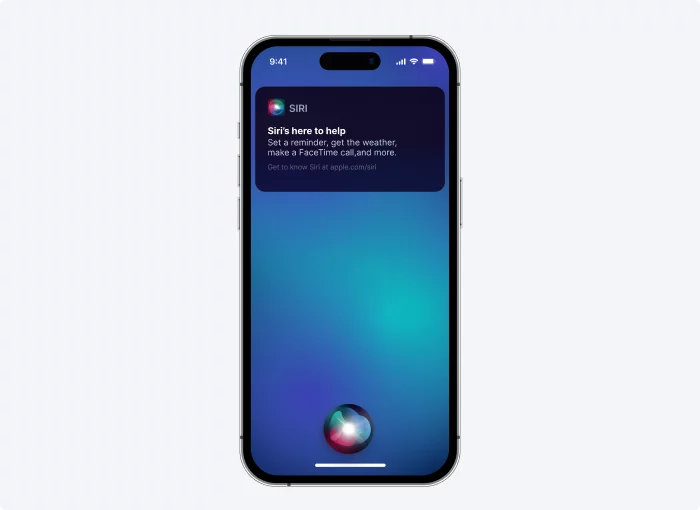
In online course creation, NLP and NLG aid in generating an engaging course idea and course content. For example, you can provide an AI assistant like ChatGPT with a course description and ask it to write lecture summaries, create lesson outlines, or suggest a course topic. You can also ask AI to give you suggestions on the best interactivities or assessment methods for your learners. Whether you’re building a mini course for a work project or creating learning content at scale for your online course business, NLP-based AI tools can serve as your reliable aids.
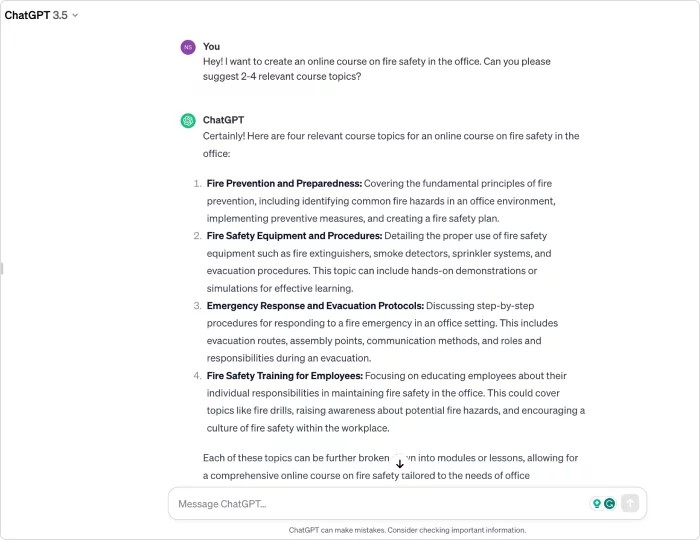
Text-to-speech (TTS)
TTS is an amazing feature that allows a program to convert written text into audible speech with a high degree of accuracy. Try AI tools like Speechify or Descript to test this feature. In an online course, you can use TTS to automatically generate audio narration for your slides. This format benefits auditory learners and those with reading difficulties. It improves accessibility by allowing learners to listen to course content, enabling learning in a variety of settings.
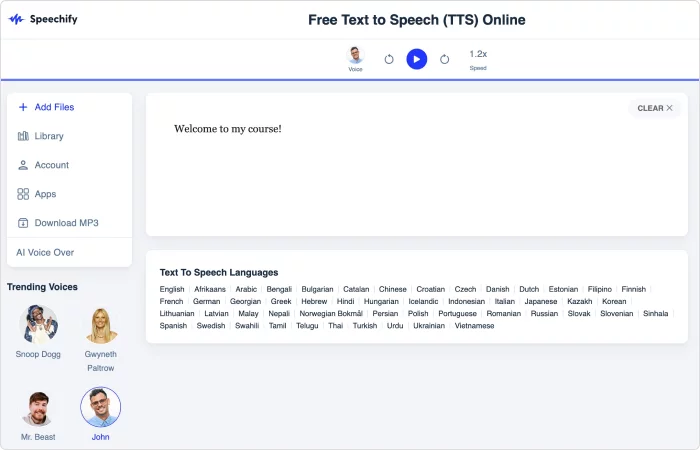
You can leverage TTS to create podcasts or supplementary audio materials for your courses. Given how podcasts have become progressively more popular over the last several years, it’s a winning strategy for engaging learners and enhancing the overall learning experience for your target audience.
Text-to-video (TTV)
TTV is exactly what it sounds like: the technology transforms textual content like a video script into video format. With the help of TTV, you can create learning videos with avatars, animations, and other multimedia elements from a short textual prompt. Videos diversify your online course content and spark learners’ interest.
Automated language translation
Who hasn’t used Google Translate or DeepL to figure out the meaning of a foreign menu item or to understand social media posts in a different language? That’s probably the most popular AI feature out there. In course creation, AI-powered translation facilitates multilingual learning, removing language barriers for diverse learner audiences. It allows course materials to be accessible and understandable to anyone, no matter where a learner is from.
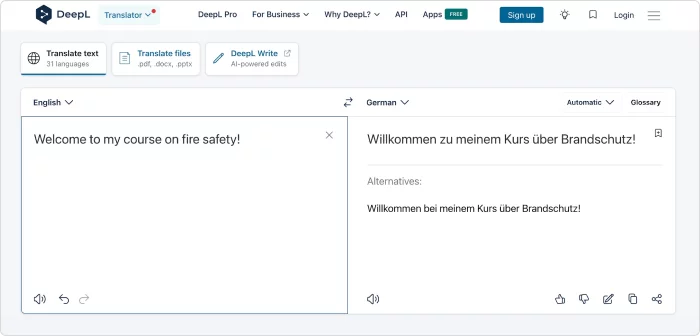
All these fantastic AI capabilities can supercharge your course creation process and make it faster, smoother, and more efficient – if you use them wisely. So, let’s take a closer look at the winning strategies for using AI course creator tools and assistants in action.
AI Course Creation Dos
Follow these actionable tips that will help you use AI tools as a productive course creation aid.
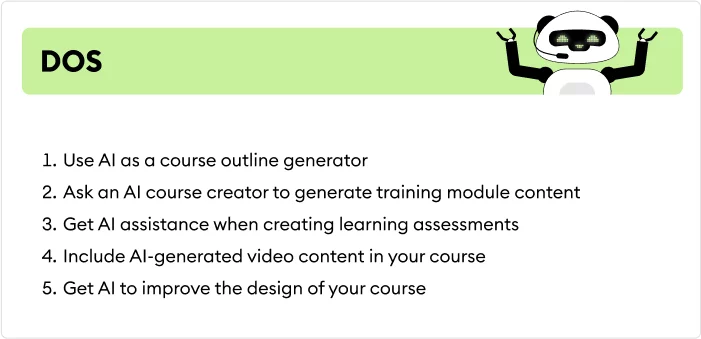
1. Use AI as a course outline generator
If there’s one thing AI is great at, it’s structuring data and presenting information in a clear, logical manner. And that’s exactly what you need when you’re developing an online course outline. So why not ask AI to generate it for you?
To see this in action, try iSpring Cloud AI, a web-based AI course creator tool with an intuitive interface. Let’s ask iSpring Cloud AI to generate an outline for a course on the best business negotiation strategies.
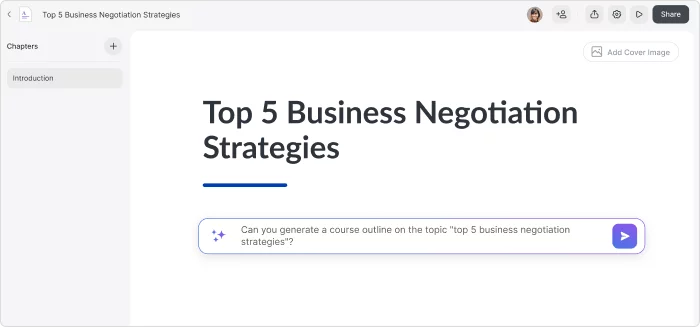
In less than a minute, the AI course generator will roll out a detailed course outline with the main topics, highlights, and conclusions. You can use the outline as is or edit it according to your learning goals and audience’s needs.
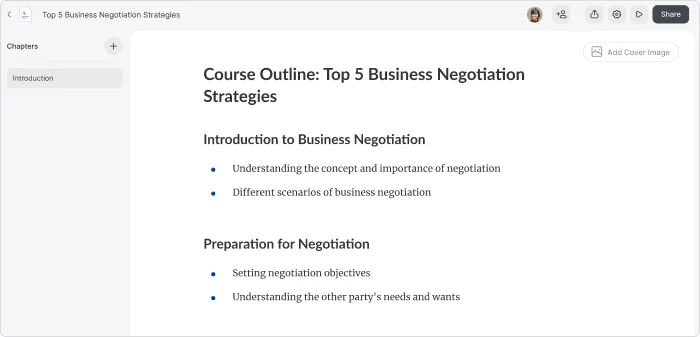
Pro tip: If you feel like the AI-generated outline is not quite what you need, try to rephrase your request (aka prompt) and ask AI to generate it again. The more you interact with AI, the higher the quality of its output.
2. Ask an AI course creator to generate training module content
Why not take it a step further and make AI your assistant for learning content writing? It can help you create course material on virtually any topic, for any level of expertise. A training module is a good example – it’s usually a targeted, bite-sized element of a larger training program that covers one specific theme or problem.
I asked iSpring AI to write content for my “Top 5 Business Negotiation Strategies” course and develop a training module on the BATNA strategy. It quickly provided a clear definition of the strategy, followed by a step-by-step training algorithm for using it as a negotiation tool. Now I can simply add the module to my course draft! I will check and review it during the quality assurance stage of course development.
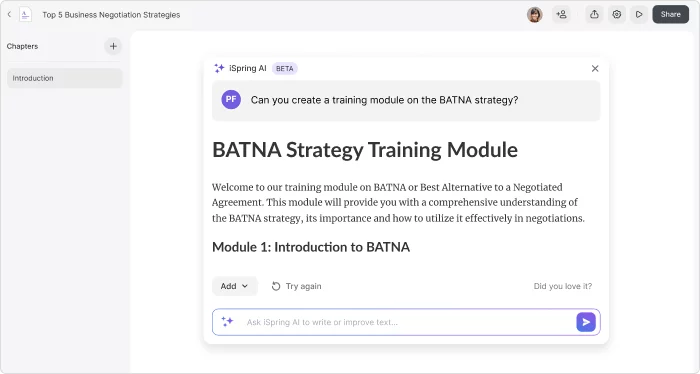
Pro tip: No matter how good the AI-generated training module content looks, remember to enrich it with your valuable human expertise. Diversify the module with industry cases, real-life examples, and other elements based on the learning objectives as well as your audience’s interests.
Also read → How to Convert Your PowerPoint Presentation to an eLearning Module
3. Get AI assistance when creating learning assessments
Creating an effective test, quiz, or other assessment can be quite a time-consuming experience. You need to go through the entire content, highlight the most important facts, and pose them as coherent questions that accurately evaluate learners’ understanding.
Now you can save time and effort by delegating this task to AI. A ChatGPT-based AI assistant and other bots can streamline this process by generating diverse, contextually relevant assessments based on the learning materials and your preferred assessment style. For example, iSpring AI created a great multiple-choice quiz for my training module within seconds.
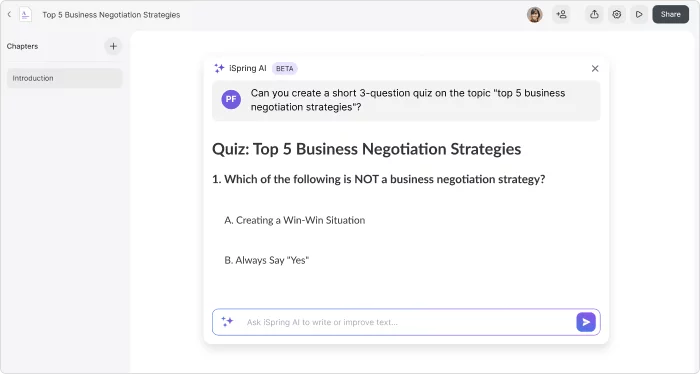
4. Include AI-generated video content in your course
If you would like to make your course more engaging and attract more potential students, especially among Gen Z, then videos might be the way to go. Enrich courses with videos made in specialized TTV software – it’s quick, easy, and a great alternative to hiring a production team.
AI video makers have a wide range of features that make videos as close to a human-produced product as possible, including:
- Ethnically diverse AI voices and avatars
- Voice cloning
- Video templates
- Professional editing settings, etc.
On platforms like Synthesia, you can create a demo course video for free. It’s useful to see how this AI tool works and determine if the software satisfies your needs and quality expectations.
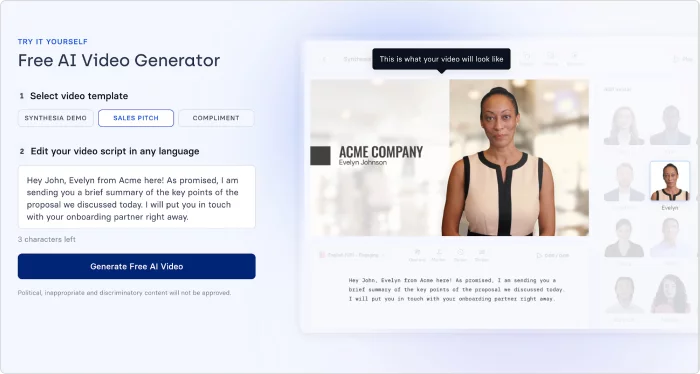
Pro tip: Ask AI to write video scripts for your course videos. Just give an AI assistant a video idea, the main ideas or topics, and the desired video duration. You can transfer the AI-generated script right onto a TTV platform and get your video ready even faster.
5. Get AI to improve the design of your course
AI can help you make your courses more visually appealing by suggesting design improvements such as a unified color palette, fonts, slide layouts, and more. If you’re experiencing a creative block, you can rely on AI for cohesive aesthetics and engaging visual elements.
Tools like Canva’s Magic Design turn your course pages into personalized templates based on your needs and course format requests. You can then edit and enhance the AI-generated templates to fit your course structure and narrative flow.
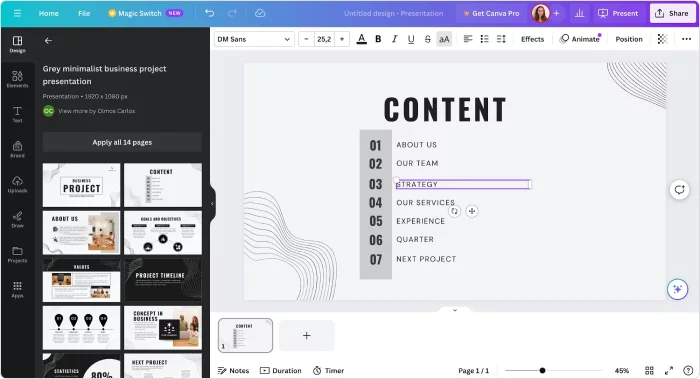
AI Course Creation Don’ts
So far, AI seems great, right? It can do virtually anything to make course building faster and easier for eLearning content creators.
However, the technology does have its flaws, and it’s good to be aware of those. Avoid the mistakes below if you want to leverage AI effectively without compromising the quality and accuracy of your course materials.
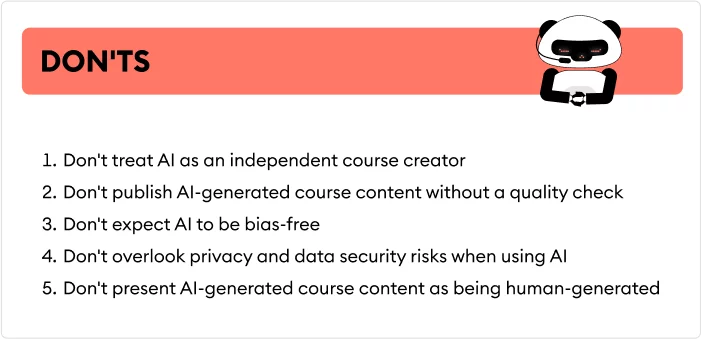
1. Don’t treat AI as an independent course creator
AI cannot autonomously replicate the expertise, creativity, and nuanced contextual understanding that’s inherent in humans. It can only assist and enhance the course creation process when combined with human knowledge and close oversight.
Keep this in mind when you bring AI into the authoring process. It’s here to help you out, not to do the job for you. That’s precisely why we don’t recommend that you simply ask AI to build an entire course for you. Yes, it can create content on the topic of your choice, but AI doesn’t know what’s important for your audience and the best way to present the materials to engage your learners.
2. Don’t publish AI-generated course content without a quality check
Quality assurance is key in course creation. Without it, you risk giving a green light to inaccurate or incomplete information that AI can inadvertently include in a course.
To make sure you don’t let any errors slip past, perform thorough reviews and verifications of AI-generated content before publishing. Here’s what you can do:
- Fact-checking. Check reputable sources to verify factual information.
- Contextual relevance. See if the content aligns with the course objectives and intended learning outcomes.
- Language and clarity. Review the course for grammatical errors, coherence, overall clarity, and logic.
3. Don’t expect AI to be bias-free
For better or for worse, AI is programmed to absorb and replicate any information and data, including biases. Let’s say you’re creating a mini-course on literature with the help of an AI-driven content generator that’s trained on historical literature, which is predominantly written by male authors. It will consistently suggest reading materials or quotes from male authors, largely ignoring female writers. This is one example of how AI can perpetuate bias in subtle ways.
You can’t avoid AI bias entirely when creating courses. What you can do, however, is review the AI-generated content and rectify any imbalances that surface in the material.
4. Don’t overlook privacy and data security risks when using AI
Using AI in course creation comes with potential risks related to privacy and data security. AI systems need a lot of data to learn, which can include personal information about students or your organization. If this data isn’t protected properly, it can potentially be accessed by unauthorized parties.
It’s important to be clear about who owns the data and get proper permission. If ownership of content or information isn’t clear, it could cause problems with how data is used or shared, breaking privacy rules. Be careful with the use of potentially sensitive data to avoid breaches of privacy regulations and ethical boundaries.
5. Don’t present AI-generated course content as being human-generated
Positioning AI-generated courses as human-made can be very misleading. For example, it can confuse learners about where the information came from and how much human work was involved. It can also be considered plagiarism in some cases, especially in an academic setting.
Be honest with your audience and let them know that certain portions of your course were created with the help of AI. Being open about AI’s role is not only ethical, but it also helps everyone understand how technology helps in making educational content.
How to Write Good Prompts for AI Course Creation
As you could see in the Dos section of this guide, using AI involves writing numerous prompts that give an AI tool instructions on what you want it to do. Creating a good prompt is a crucial skill for a content creator to have; it serves as the blueprint that guides the AI in the desired direction.
A well-crafted prompt should be clear, specific, and detailed. The more parameters you set for AI, the more targeted output you’ll get. When you’re writing a prompt, remember to mention:
- Learning objective and/or topic description. Establish the context and inform the AI assistant about the overall theme of the course content.
- Specific task instruction. Clearly state the task or action the AI should perform.
- Content requirements. Specify any content elements or formats you want AI to include in the output.
- Intended audience. Clarify the profile of the target audience.
- Evaluation criteria. Set standards or criteria for evaluating the generated content.
Together, these elements form a comprehensive prompt and provide all the details needed for AI to generate exactly the kind of content you need for your course. Let’s look at a couple of examples:
Example 1. A prompt for course content generation
Let’s say you need AI to suggest content ideas for a mini course. It might look like this:
“Create a content structure for a mini-course sustainable living practices. Suggest 2-3 concise module topics that cover sustainable lifestyle choices, eco-friendly habits, and environmental impact awareness. Ensure the content includes tips, examples, and case studies illustrating sustainable practices. Focus on beginners who need clear explanations and simple, practical advice. The content should be accurate and applicable to real-life situations.“
I pasted this prompt into iSpring Cloud AI, and iSpring AI generated a multi-module course structure with relevant content ideas in just under a minute.
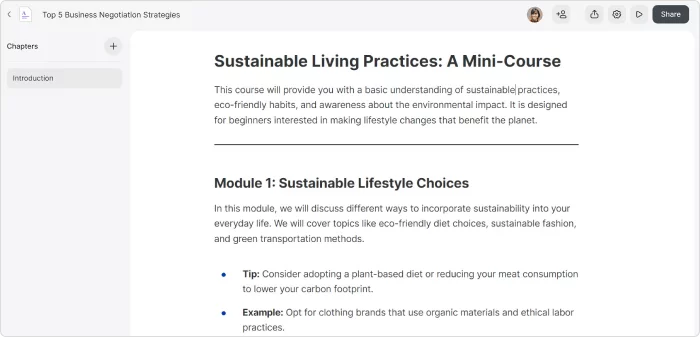
Example 2. A prompt for video script generation
You can ask AI to create a video script for your course using the same prompt structure. For example:
“Write a video script with the title ‘5 Practical Steps Toward Sustainable Living.’ Outline clear, impactful strategies for eco-conscious living, supported by facts and storytelling. Give real-life examples that support the arguments. Cater to individuals aged 18–30 who are seeking easy-to-follow tips and simple lifestyle changes. The video should be under 3 minutes long.“
Once again, iSpring AI quickly processed the request and rolled out a detailed video script. Now I can hand it over to a production team or use it with a TTV tool.
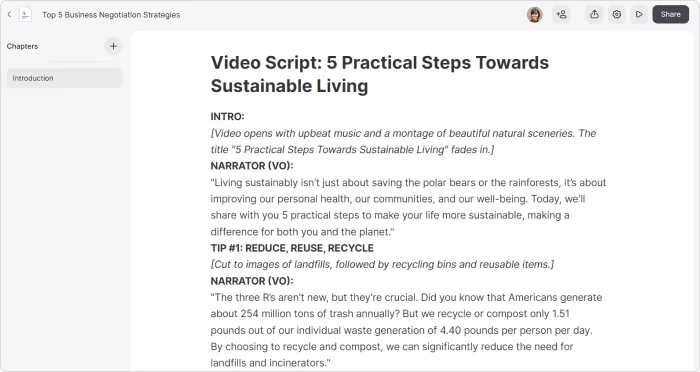
Pro tip: The best way to learn to create excellent prompts is to experiment continuously. Try rephrasing your request to AI several times and comparing the outcomes. Eventually, you may work out your own set of prompt-writing rules that work for your eLearning purposes.
FAQ on AI Course Content Creation
Read on to find answers to the questions people most often ask about creating online courses with AI.
Can AI be creative?
AI does demonstrate creativity by generating content, but it relies on patterns from existing data. In other words, it reworks and combines information it has seen before to synthesize something, rather than inventing entirely novel ideas like humans do.
This means that AI cannot be creative and imaginative, at least not as we traditionally understand these notions.
Can AI personalize course content for individual learners?
Yes, AI can personalize content by analyzing data on a learner’s behavior, preferences, and performance. AI-powered learning management systems can adapt content based on this analysis, tailoring it to suit each learner’s needs.
Can AI help in assessing learner progress or identifying areas for improvement?
Totally! AI can analyze learner data and generate precise progress reports. It’s also capable of identifying a learner’s weak areas and suggesting improvements to enhance their learning journey.
Final Thoughts
Numerous AI tools are available to aid you in the process of online course creation. Use them to write a compelling course description, craft expert learning content, generate engaging videos, translate courses into foreign languages, and more. Just be sure to use AI responsibly and not over-rely on its assistance.
Supercharge your authoring efforts with iSpring Cloud AI, an AI-powered course creation tool that works right in a browser. Try iSpring Cloud AI for free today and enjoy smart course creation at lightning speed!




